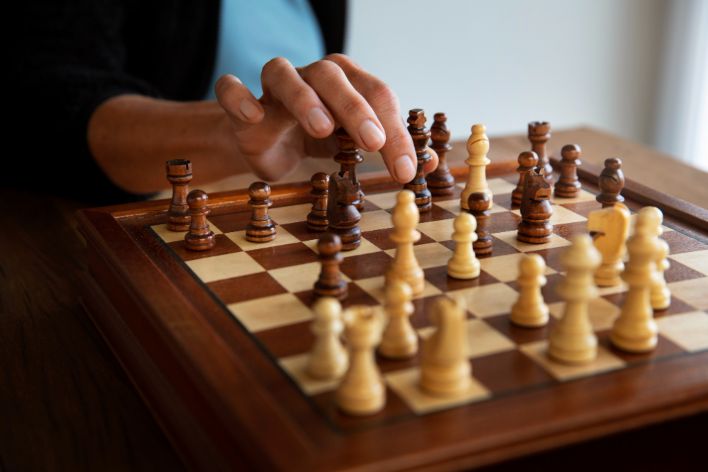Chess Tactics and Combinations
By Pinkey Sharma |
Date 07-08-2024

Table of Contents
- Understanding Tactical Motifs
- How Children Can Identify Tactical Motifs
- Solve Chess Puzzles and Improve Calculation Skills
- Strategies for Setting Traps and Avoiding Blunders
- Chess Tactics to Win
- Difference Between Chess Tactics and Chess Combinations
- Chess Tactics vs Strategy
- Chess Moves Combinations
- Chess Tactics Explained
- Chess Tactics and Combinations Followed by the Masters
- Conclusion
- FAQS (Frequently Asked Questions)
- Related blogs:
Admissions Open for
Sometimes chess is referred to as a battle of wits, with players devising long-term plans and profiting from short-term tactics. Playing better chess involves learning chess tactics and combinations, which would be especially crucial for children entering the game for the very first time. The article will take one through various ways concerning chess tactics to win by guiding one on the identification of tactical motifs, solving of puzzles, setting of traps, and ways of avoiding blunders. Coupled with these would be how tactics in chess differ from strategy and get an insight into moves and combinations used by masters.
What Are Tactical Motifs in Chess and How Can Kids Recognize Them?
Understanding Tactical Motifs
Tactical motifs refer to those patterns in chess that keep on repeating to give a clear plus, such as material or checkmate. In order to execute successful chess tactics to win, the player must know and understand these motifs. Some of the common motifs include:
• Forks: It is a basic tactic in which a single piece attacks two or more enemy pieces simultaneously.
• Pins: Sometimes, a piece cannot be moved as its movement could lead to losing a more valuable defending piece.
• Skewers: It is the opposite of Pins. A precious piece is attacked and must move, thereby exposing a less valuable piece behind it.
• Discovered Attacks: One moving piece reveals an attack by another piece.
• Double Checks: Two pieces are checking the opponent king simultaneously, thereby defending against it is troublesome.
How Children Can Identify Tactical Motifs
1. Pattern Recognition: The children need to practice solving vast amounts of chess puzzles focused on the motifs. Through the repetition, the child will develop the ability to recognize such patterns in real games.
2. Visualization Exercises: Try to make a child guess moves and their consequences to develop tactically.
3. Chess Software: Most chess software and apps include a lot of puzzles and exercises to teach tactical motifs in the most interactive and funny way possible.
4. Coaching and Mentorship: Seeking guidance from experienced players or coaches who can identify the motifs in real-time will help the learning curve immensely.
Solve Chess Puzzles and Improve Calculation Skills

Steps to Solving Chess Puzzles
1. Understand the Position: A player needs to carefully look over the board to find out where everything stands and if threats or opportunities exist.
2. Look for Tactical Motifs: Typical tactical motifs need to be looked for, such as forks, pins, skewers, and discovered attacks.
3. Calculate Variations: The player must, in his mind, go through the whole range of possible moves and counter-moves for something to look for that would turn out to be a better solution.
4. Check Your Solution: Recheck your calculation to make sure that no threat has been overlooked, and neither has some better alternative.
5. Play the Move: When ready, play the move that secures maximum advantage.
Calculation Skills: How to Improve
• Practice regularly: Doing enough puzzles and tactics will sharpen your skills of calculation with time.
• Gradual progression: Try easier puzzles and progress to harder ones; this helps in developing confidence and skills.
• Game Analysis: This can be considered as one of the chess tactics to win. Go through your games and those of chess masters, trying to comprehend the tactical aspects of these as well as the choices that were made.
• Time Management: Try and solve the puzzles against the time to increase speed and efficiency.
Strategies for Setting Traps and Avoiding Blunders
Setting Traps
1. Luring the Opponent: Set up positions which invite your opponent to make a blunder, for example to leave a piece or fall into a fork.
2. Hidden threats: Conceal your true intentions by making innocent-looking moves, which set up a tactical strike.
3. Divert attention: Make some moves which mislead your opponent about what you really intend to do. This should keep him looking at the wrong part of the board.
Avoiding Blunders
1. Double-checking the moves: Never play a move until you have checked that it won't lead to tactical motifs like forks or pins.
2. Keeping focused: Any lapse in concentration typically leads to blunders.
3. Safe Moves: As far as possible, make those moves that better your position without introducing unwarranted risks into the game.
4. Learn from Mistakes: Go over your games and try to realize the blunder—what happened, how it could have been prevented.
Chess Tactics to Win
Mastering Tactical Themes
There are many tactical themes that players should learn and practice to make the game successful. Few chess tactics to win include:
• Sacrifices: Material is given up, at least for the time being, to achieve strategic or tactical advantage.
• Zwischenzug: An intermediate move, fitted in between an opponent's sequence of moves, thus destroying his plan.

• Back Rank Mate: Checkmate by exploiting a weak back rank usually with the support of a rook or queen.

Common Tactics That Win
1. Knight Forks: Of all the pieces, it is particularly adept at forking two pieces due to its nature of movement.
2. Rook Lifts: Transferring a rook up to the third or fourth rank to attack the king.
3. Queen Sacrifices: Sacrificing the queen either to mate decisively or to win large amounts of material.
Difference Between Chess Tactics and Chess Combinations
One of the most important ideas to be learned about chess is how tactics differ from combinations, advancing playing skills.
Chess tactics refer to very short-term, definite moves to accomplish an immediate purpose, like winning material or giving checkmate, or securing a positional advantage. It typically involves pattern recognition and the actualization of quick sequences, forks, pins, and skewers. For instance, a knight fork where both the opponent's king and queen are attacked at the same time is a tactical move. Tactics are usually simple and involve one to three moves.
Well, chess combinations are more complex forms of combinations that involve several tactical themes working together in a sequence. A combination may include sacrifice for the opening of lines to a sequence of forced moves that result in a plus, decisive in character. Combinations require deeper calculation and often extend over several moves, melding multiple tactical motifs together toward the attainment of a larger goal. For example, sacrificing a queen only to set up a checkmate three moves later involves a combination.
While tactics are immediate, usually simple sequences that involve getting an advantage, combinations are long and complicated sequences stringing several tactics together to achieve some strategic outcome. Becoming a good chess player requires mastery of both.
Chess Tactics vs Strategy
Knowing the Difference
• Tactics: Tactics are short-term, immediate sequences of moves aimed at achieving an advantage. Very often, they include direct threats, such as checkmate or winning material.
• Strategy: A long-term plan and positional play which aims at improving the general position. It is called controlling central squares and preparing a future tactical struggle.
Tactics and Strategies—Putting Them Together
A good chess player has to mix tactics with strategy. The strategic plans set the condition for the tactics, while the execution of the tactics bring a strategic advantage. For example, very often, the strategic objective of controlling the center gives birth to tactical opportunities.
Chess Moves Combinations
Common Combinations
• Double Attack: A combination against more than one piece or square that crushes the opponent.
• Discovered Check: A tactic where a piece moves and uncovers a check from another piece to gain a large material advantage.
• Smothered Mate: Checkmating the enemy king by surrounding it with his own pieces, usually involving a knight.
Famous Combinations
• The Evergreen Game: A beautiful game played by Adolf Anderssen, in which he demonstrated a great combination of sacrifices that ultimately ended in checkmate.
• The Immortal Game: This is yet another classic from Anderssen, where a variety of sacrifices are topped by a most brilliant victory.
Chess Tactics Explained
Importance of Tactical Training
It sharpens tactical skills, sharpens the mind, and calculation before any chess player ranging from a beginner to master. With regular practice, it helps in recognizing the patterns and executing chess tactics to win. Below are some Tactic tools for learning:
1. Books and Resources: Many books are available regarding chess tactics with numerous puzzles, explanations.
2. Online platforms: Websites like Chess.com and Lichess are very helpful in terms of practice with tactics.
3. Chess Clubs: A chess club exposes one to several experienced players who can be of much help in these tactical exercises.
Chess Tactics and Combinations Followed by the Masters
Master Games Examples
• Garry Kasparov: With his great deep tactical understanding, Kasparov's complex combinations often tear apart opponents.
• Bobby Fischer: The fact that Fischer was a great tactician is proven in his "Game of the Century," in which he sacrificed his queen for a winning attack.
• Magnus Carlsen: The current world champion, Carlsen combines strategy and tactics with ease. He often finds surprising tactical resources in positions that look equal.
Games by masters are a real eye-opener of advanced tactics and combinations. One gets the underlying motifs by analysis of their moves to be able to come up with their own chess tactics to win consistently.
Integrating Tactics into Your Game
For best practices in integrating tactics into your game, the following steps have to be considered:
1. Going through Master Games: Always try and go through games played by top players and learn how they used tactics.
2. Practice Puzzles: Engage oneself in puzzles that require one to find out the best tactical solution.
3. Play Regularly: What is learned regularly applies in real-game situations.
4. Seek Feedback: Coaches or stronger players can help through feedback on your tactical play and can provide sophisticated chess tactics to win.
Conclusion
Mastering chess tactics and combinations is the proper guideline when one is trying to improve in chess. The identification of the Tactical Motifs, the solving of puzzles, the setting of traps, and the understanding of the difference between tactics and strategy are all important in becoming a stronger player. One can improve their chess tactics to win through the study of master games and regular practice in applying tactics for winning more games. That makes the process of learning and perfecting tactics challenging yet rewarding, be it for a pure beginner or an advanced player.
FAQS (Frequently Asked Questions)
What is the strongest tactic in chess?
The “Double Attack” is considered as the strongest among the various chess tactics to win. It happens when a player moves a single piece that creates a simultaneous threat to two pieces of the opponent. It can create a bigger blow to the opponent if his two pieces are powerful out of which only one has a chance to escape.
What is illegal 1 in chess?
It refers to an illegal move of the pieces that is against the rules of the game. For example, a rook cannot be moved diagonally or a bishop cannot be moved horizontally or vertically, a player cannot move a piece that puts his King in a “check” position, no pieces can jump over other pieces except the knight.
What is the last move in chess?
The “checkmate” is the last move in chess that brings the game to an end. This indicates that the winning player has captured the opponent’s King.
What is the 75-move rule?
If no piece is captured and no movement of pawn has occurred in the last 75 moves by either of the players, the game is declared as a draw.
Liked what you read? Feel free to share this article with your chess-loving friends and spread the knowledge!
Related blogs:
Learn Chess strategies:Become a chess master with key strategies.
Developing a Chess Study Routine: Explore your chess skills by developing a structured study routine.
Chess and Technology: Explore how AI and tech revolutionize chess with innovative strategies!
CBSE Schools In Popular Cities
- CBSE Schools in Bangalore
- CBSE Schools in Mumbai
- CBSE Schools in Pune
- CBSE Schools in Hyderabad
- CBSE Schools in Chennai
- CBSE Schools in Gurgaon
- CBSE Schools in Kolkata
- CBSE Schools in Indore
- CBSE Schools in Sonipat
- CBSE Schools in Delhi
- CBSE Schools in Rohtak
- CBSE Schools in Bhopal
- CBSE Schools in Aurangabad
- CBSE Schools in Jabalpur
- CBSE Schools in Jaipur
- CBSE Schools in Jodhpur
- CBSE Schools in Nagpur
- CBSE Schools in Ahmednagar
- CBSE School In Tumkur

Call Us to know more about Orchids
Swipe Up


.jpg&w=1920&q=80)













